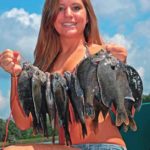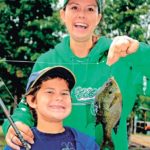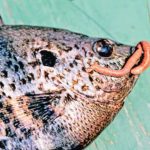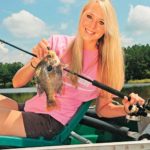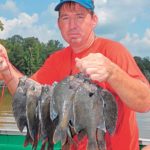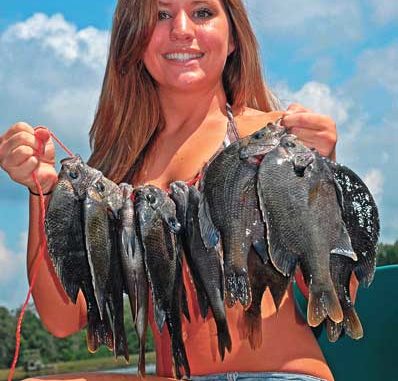
Fish any of these lakes this month, and the stringer of bream you bring home very well may be longer than your fishing pole.
Most of the time you’ll find bream not as big as crappie and not as heavy as bass or catfish. You may have to clean quite a few, especially if you fillet them, to feed a family for a Friday night fish fry.
But fishermen still consider the bluegill and the chinquapin (also known as the redear sunfish or the shellcracker) as two of the tastiest freshwater fish in the Bayou State. Generally you can locate and catch these bream best in May, the prime spawning time for bluegill.
Bluegill will continue to spawn often until the end of June and sometimes even into July. The full moon influences the bream spawn, and most bream fishermen report a few days before, during and after the full moon as the most productive time to catch both bluegill and chinquapin.
Anglers can catch bream in almost every lake, river, pond and puddle in the state. To learn where you need to fish to catch them, how to find the fish and how to catch them, Louisiana Sportsman talked with Mike Wood, fisheries biologist manager for the Department of Wildlife and Fisheries District 2.
When asked to identify the three best bluegill lakes in the state, Wood named Toledo Bend, Yucatan Lake and Lake Providence.
Let’s take a look at each of these lakes, and learn how and where to find the bream beds this month at these lakes.
Deep bream at Toledo Bend
“Toledo Bend offers a unique fishing experience for bream fishermen,” Wood said. “It has pretty clear water, which allows the bream to spawn much deeper than they do in other lakes, rivers and reservoirs throughout Louisiana. The bream at Toledo Bend often will spawn as deep as 20 feet.”
To fish for deep-water bream, position your boat right over the bed, and either fish with a tight line or a bobber that won’t spook the bream when they’re concentrated in deep water.
“The bream beds you’ll find in that 20-foot-deep water are huge,” Wood said. “If you could see down under the water, you’d see that these areas are pock-marked with bream beds. So, you can sit on one spot, fish all the way around the boat and catch plenty of bluegill.”
However, you can’t see those bream beds 20 feet below you. Use your depth finder to search for humps and ridges, both areas typically more sandy than mud bottoms.
Many people fish every May on this lake’s historic bream beds. When you ride up and down the lake and see people fishing away from the bank and catching bream, you’ll know they’re probably sitting on one of those big beds. However, you still can pinpoint bream beds folks may not have identified if you use your depth finder to look for ridges and humps on the bottom.
“One of the best ways to find these deep-water beds is with side-scanning sonar,” Wood said. “These new depth finders are great for locating bream beds and any type of underwater structure and species of fish. When you look at the screen of a side-scanning depth finder, the screen almost looks like a picture. These devices use sound as a camera to record any object on the bottom or between the bottom and the surface.
“Bream beds, in particular, show up really well on side-scanning sonar, and they’re really easy to find, even in deep water.”
You’ll catch primarily bluegill at Toledo Bend, but you also will catch some chinquapin along with the bluegill, depending on the beds you’re fishing. Wood has chosen Toledo Bend as one of his top picks because it holds plenty of bream concentrated in its deep water.
“You can catch some fairly large bream in this lake that often weigh up to almost a pound,” Wood said.
Wood mentioned that the chinquapin will spawn as deep as the bluegill, a surprising fact since generally anglers catch chinquapin in much more shallow water, often along reed beds or water grass and on shell banks.
“If you’ll be fishing for chinquapin, I suggest using worms,” Wood said. “But if you’ll be fishing for bluegill, you can’t beat crickets. If you fish with worms, you’ll triple the number of shellcrackers you’ll catch than if you just fish with crickets.”
Wood says any type of live earthworm will produce chinquapin. In deep, clear water, many fishermen prefer to use a piece of the nightcrawler, thread it on the hook and completely hide the hook, leaving only a small portion of either the head or the tail extending past the point of the hook inside the worm.
Also, when fishing in deep, clear water, lighter line usually will produce more bream than heavier line. Four- to 6-pound-test fluorocarbon line works best, but since you won’t have to worry about getting hung up, you may want to consider fishing 2-pound-test fluorocarbon line and setting the drag fairly light. The line needs to deliver the force to set the hook, and then you can allow the drag on your reel to keep enough pressure on the line to let the bream wear itself out.
Yucatan for monsters
“Yucatan Lake is an active Mississippi River oxbow lake near Vicksburg,” Wood said. “Timing is the trick to finding and catching the big bream of the Yucatan. When the Mississippi River gets down to 19 (feet) at Vicksburg and is slowly falling, the bream bite in Yucatan Lake turns on this month.”
This old oxbow lake that’s directly connected to the Mississippi River rises and falls with the river.
“Many people may think that what I’m about to say is just a fish tale, but if you find the right bream beds at the Yucatan, you almost can average 1-pound fish for the bluegill you catch there,” Wood said. “These bluegills are the biggest I’ve ever seen.”
A really wide oxbow in the central part of Louisiana near Newellton, Yucatan was part of the Mississippi River at one time. The age of the lake means it has cypress trees growing along the shoreline, and the water beneath those cypress trees has ground firm enough on which the bream can bed.
“The best way to fish Yucatan in May is to move under the shade of the big cypress trees and drop-fish along them until you find the bream beds under the trees and out in the underwater roots of the cypresses,” Wood said. “Once you start catching bream and determine where the beds are located, back away from the beds, anchor down and start casting to them. Don’t just try to sit on top of the beds since they won’t be very deep. You probably won’t find them in water more than 5 feet deep.”
Because Yucatan stays open and active, with water flowing into and out of the lake, it’s very fertile and transfers that fertility to the bream caught there. This month, if you’re looking for a really great bluegill lake in the middle section of the state, don’t overlook Yucatan.
Numbers at Lake Providence
Biologists classify Lake Providence near the town of Lake Providence as an inactive oxbow off the Mississippi River. But it holds a number of bream.
“The large bream in Lake Providence probably will weigh 1/2-pound, which is a nice, big bull bluegill,” Wood said. “You can go around the perimeter of Lake Providence, drop-fish and find dozens of bream beds. When you spook the bream on one bed, you can move to the next one and continue to catch bream. You can make a milk run on Lake Providence, moving from bed to bed, just like tournament bass fishermen do when they fish different locations on the same body of water.”
Wood said anglers know Providence more for its bluegill fishing than its chinquapin fishing. Although chinquapin do live at Lake Providence, when you’re bream fishing, you’ll catch more bluegill. You can fish with worms, crickets or artificial lures for bream in this lake. Look for them holding in water 4 feet deep or less.
Caney and Grand Bayou
Louisiana features two fine chinquapin lakes — Caney near Jonesboro and Grand Bayou Reservoir near Coushatta.
Caney Lake, about 5,000 acres, has very clear water. Almost all of the state-record chinquapin come from Caney Lake. This lake has a number of shell beds in 9 to 10 feet of open water where most people don’t fish but where some anglers catch big chinquapins.
Most people who know how to catch the big chinquapins of Caney Lake fish with tight lines and exclusively with worms. You’ll need your depth finder there, and a side-scanning depth finder will help you locate the beds more easily.
Wood said anglers often find chinquapin fishing slowly.
“The chinquapin are finicky feeders,” he said. “Their spawn is directly related to the full moon. Caney chinquapin begin to spawn around the full moon from March through July, and will even have a spawn in September and October, which seems to be unique to this lake. The chinquapin may spawn in September and October on other lakes, but I know for certain that they spawn on Caney Lake during these two months of the fall, because I’ve seen them on the beds every year.
“Grand Bayou Reservoir near Coushatta is very similar in size and appearance to Caney, although slightly smaller. Many chinquapin fishermen who fish Caney also fish Grand Bayou because finding the beds and catching the chinquapin is very similar on these two lakes.
“Since this is a clear-water lake, the chinquapin will be spawning in clear water 9 to 10 feet deep as in Caney Lake. When the water gets really hot in late June or July, the chinquapin will stop spawning, but then they start up again in September.”
Louisiana, without question, has some of the best bream fishing in North America in May.
